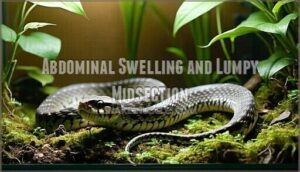This site is supported by our readers. We may earn a commission, at no cost to you, if you purchase through links.

Most keepers notice the transformation around three weeks post-breeding, when abdominal swelling replaces her once-smooth profile with an asymmetric, triangular contour. But physical changes tell only part of the story. Behavioral shifts—sudden food refusal, relentless burrowing, defensive coiling—signal hormonal cascades that prepare her body for oviposition.
Recognizing these signs early allows you to provide targeted husbandry adjustments, monitor her health through gestation, and prepare for the critical window when she’ll seek a secure retreat to deposit her clutch.
Table Of Contents
Key Takeaways
- When you spot firm, oval lumps in your corn snake’s midsection paired with abdominal swelling and behavioral shifts like food refusal or increased burrowing around three weeks post-breeding, you’re witnessing the physical transformation of gravidity that demands immediate husbandry adjustments.
- The pre-laying shed occurring 2-3 weeks before egg deposition serves as your most reliable countdown marker, with oviposition typically following within 10-21 days—giving you a precise window to finalize nest box placement and environmental conditions.
- Gravid females require strict stress reduction protocols including minimal handling (once weekly maximum), stable temperature gradients of 78-88°F, and 40-60% humidity, since excessive interaction or environmental instability can trigger dangerous complications like premature oviposition or egg retention.
- Red flags demanding immediate veterinary intervention include persistent abdominal swelling beyond seven days post-lay, rapid weight loss exceeding 10% of pre-breeding mass, or any delay in egg laying more than 24 hours after the pre-lay shed—conditions that carry up to 50% mortality risk if left untreated.
Physical Signs Your Corn Snake is Gravid
When your corn snake is gravid, her body undergoes distinct physical transformations that you can observe and measure. These changes usually progress over several weeks as the eggs develop internally.
Understanding these clinical signs will help you distinguish normal gravidity from other conditions and provide appropriate care throughout gestation.
Abdominal Swelling and Lumpy Midsection
One of the earliest and most reliable indicators you’ll notice is a distinct swelling in your corn snake’s lower abdomen, often accompanied by a lumpy or uneven appearance as individual eggs begin to take shape. This abdominal enlargement usually becomes visible in the lower third of the body, where you can detect a string of firm, evenly-spaced swellings through gentle snake palpation—each representing a developing egg.
- The midsection bulge transforms your snake’s normally smooth profile into a triangular, asymmetric contour
- Gravid signs intensify as egg development progresses, making lumps increasingly palpable
- Your corn snake’s body may appear stretched or distended compared to her pre-breeding condition
- These physical changes in gravid snakes become most apparent 3-4 weeks post-ovulation during snake reproduction
Weight Gain and Increased Girth
As your corn snake’s eggs mature internally, you’ll notice measurable weight gain—often up to 30% of her baseline body mass—alongside a pronounced increase in girth that gives her lower body a fuller, more sturdy appearance.
Regular weight monitoring during gestation growth helps you track abdominal expansion and confirm gravidity. You can document this body mass increase by weighing your gravid snake weekly, comparing measurements to her pre-breeding weight.
This girth measurement provides objective data about your snake’s reproductive health and validates visible swelling you’re observing in her midsection.
Color Changes and Pattern Contrast
Beyond the obvious bulk, hormonal shifts during gravidity often intensify your corn snake’s coloration, making her patterns appear darker and more vibrant against a slightly lighter or "glowing" background. These pigmentation shifts and pattern alterations serve as visual cues during snake reproduction.
You’ll observe increased color intensity in her saddles and markings—subtle hue changes that reflect the physiological demands of gestation in your gravid snake, distinguishing her appearance from her typical non-breeding state.
Pre-Laying Shed (2-3 Weeks Before Eggs)
About two to three weeks before your corn snake lays her eggs, you’ll notice a dramatic pre-laying shed—a final skin renewal that readies her body for the physical demands of oviposition and signals the countdown to egg deposition has begun. This shedding process coincides with late-stage egg development and represents a critical gravidity sign in corn snake reproduction.
During this pre-lay care period, monitor your gravid snake closely and secure proper snake nutrition and reptile care protocols, as egg laying usually follows within 14–21 days.
- Cloudy, opaque eyes indicate the onset of the pre-lay shed cycle
- Dull, hazy scales replace her normal glossy appearance during ecdysis
- Completion of shedding signals imminent oviposition within 10–21 days
- Post-shed clarity marks the final phase before egg deposition
Behavioral Changes in Gravid Corn Snakes
When your corn snake is gravid, you’ll notice distinct shifts in how she behaves day to day. These changes stem from hormonal fluctuations and the physical demands of carrying eggs, making her act differently than usual.
Understanding these behavioral cues helps you recognize gravidity early and adjust her care accordingly.
Loss of Appetite and Food Refusal
One of the most reliable signals your corn snake is gravid is when she suddenly turns her nose up at her favorite meal—over 70% of pregnant females refuse food within 7 to 14 days after ovulation.
This feeding cessation stems from appetite suppression driven by hormonal shifts and physical compression as eggs develop.
Don’t panic when your gravid snake ignores prey—this hunger pattern change is normal, not a nutrition deficit requiring intervention.
Increased Restlessness and Burrowing
As egg mass increases and pressure mounts in her lower body, your gravid corn snake will often pace her enclosure with nervous energy—rearranging substrate, pushing into corners, and burrowing repeatedly as if searching for the perfect spot she can’t quite find. This restlessness escalates during the pre-lay period, driven by hormonal surges and physical discomfort as embryos grow.
As egg mass increases, your gravid corn snake paces with nervous energy, rearranging substrate and burrowing repeatedly as restlessness escalates during the pre-lay period
Burrowing behavior intensifies as nesting instincts kick in, prompting your gravid snake to dig, tunnel, and test substrate depth—normal gravidity signs you shouldn’t interpret as distress requiring intervention.
Bowl Coiling and Prolonged Basking
You might notice your gravid corn snake draping herself around her water bowl or spending hours in her basking zone—two thermal regulation strategies she uses to maintain the steady warmth her developing eggs demand.
Bowl coiling provides conductive heat transfer and moisture absorption, while prolonged basking behavior can increase by 50% during gravid posturing.
These coiling patterns reflect precise thermal regulation needs in snake reproduction, not illness—your corn snake instinctively optimizes temperature for embryonic development.
Reduced Handling Tolerance and Defensiveness
During the final two weeks of gravidity, your corn snake may shift from her usual calm demeanor to a noticeably defensive posture—musking, striking, or retreating when you approach—signaling that hormonal surges and protective instincts have overridden her tolerance for routine interaction.
Interaction precautions become critical: suspend non-essential contact, implement stress reduction protocols, and respect her defensive posturing as adaptive aggression management rather than pathology.
Providing environmental enrichment—secure hides, stable temperature gradients—facilitates natural reptile behavior during this vulnerable phase of snake reproduction, ensuring both maternal welfare and successful egg deposition in your gravid snake.
How to Confirm Your Corn Snake is Gravid
Once you’ve spotted the physical and behavioral signs, confirming gravidity requires more direct assessment methods.
Palpation, imaging, and weight tracking can verify pregnancy with greater certainty.
Here’s how you can confirm your corn snake is carrying eggs.
Gentle Palpation Techniques
Palpation—running your fingertips along your snake’s lower body to feel for firm, oval masses—remains the most accessible diagnostic method for detecting eggs, though it demands patience and a trained touch to avoid misinterpreting muscle tone or fecal matter as developing follicles.
Start behind the ribs and apply gentle pressure while moving toward the tail, feeling for distinct, bead-like structures in the lower third of the body. Palpable eggs present as firm, fixed masses that don’t shift easily under your fingertips—unlike retained feces, which feel softer and more mobile during abdominal checks.
Ultrasound and X-Ray Imaging
When hands-on palpation leaves you uncertain, diagnostic imaging techniques—particularly ultrasound and X-ray—provide objective confirmation of gravidity with measurable diagnostic accuracy, transforming guesswork into evidence-based reproductive monitoring of your corn snake’s condition.
- Ultrasound examination detects ovarian follicles and developing eggs with over 90% accuracy, posing no radiation safety concerns for repeated assessments throughout gestation.
- X-ray imaging visualizes calcified eggs 20–30 days post-ovulation, offering near-perfect egg visualization once shells harden.
- Serial ultrasound tracking facilitates precise reproductive monitoring by measuring follicle size and echogenicity changes in viviparous and oviparous species alike.
- Veterinary consultation ensures proper interpretation of imaging results, distinguishing normal gravid snake progression from retention complications affecting reptile health.
For accurate diagnosis, understanding reptile ultrasonography is essential in determining the health of your corn snake.
Monitoring Body Weight Changes
While imaging confirms the presence of eggs, tracking your corn snake’s body weight over time reveals the progressive metabolic demands of gravidity and alerts you to complications before clinical signs become obvious.
Gravid snakes usually show weight gain patterns of 20–30% above baseline body mass index as eggs develop, so using a digital scale with 0.1-gram accuracy ensures precise gestation tracking.
Sudden weight fluctuations—particularly rapid loss—may signal egg absorption or retention, demanding immediate reptile health assessment to safeguard both your gravid snake and her clutch.
Tracking Post-Breeding Timeline
Knowing when your snake ovulated and when you first observed breeding behavior gives you the timeline markers to predict egg-laying with surprising precision. Most corn snakes follow a gestation period of 30–45 days post-ovulation, with egg development accelerating in the final two weeks.
By tracking these pregnancy stages within the breeding cycle, you’ll anticipate the pre-lay shed and prepare your gravid snake’s environment accordingly. This post-breeding care strategy ensures you’re ready when snake reproduction reaches its critical phase.
Caring for Your Gravid Corn Snake
Once you’ve confirmed your corn snake is gravid, your focus shifts to creating conditions that support healthy egg development and minimize complications.
The next several weeks require careful attention to environmental parameters, stress reduction, and ongoing health monitoring.
Let’s look at the specific care adjustments you’ll need to make during this critical period.
Maintaining Optimal Temperature and Humidity
Temperature and humidity aren’t just background details—they’re the foundation of your gravid corn snake’s ability to develop healthy eggs and stay physiologically stable through the demands of gestation.
During the gravid period, maintain a thermal gradient of 78–82°F on the cool side and 85–88°F on the warm end using reliable heating options like under-tank heaters or ceramic emitters.
Humidity levels should hover between 40–60%, supporting thermoregulation and preventing dystocia without compromising ventilation systems or encouraging respiratory infections in reptile reproduction.
Providing a Suitable Nest Box
Once your gravid corn snake has the right ambient conditions, she’ll need a dedicated nest box—a secure, enclosed space that satisfies her instinct to deposit eggs in a sheltered, humid microenvironment where they won’t dry out or face predation.
Design your laying box with these specifications:
- Opaque container with a single entrance hole (2–3 inches diameter) to minimize light penetration and disturbance
- Moist sphagnum moss or vermiculite as egg laying substrate, dampened to approximately 80% humidity without waterlogging
- Dimensions allowing the snake to fully coil inside (usually 10–12 inches for adult corn snakes)
- Stable incubation temperature gradient accessible nearby (82–85°F) to support nesting behavior throughout the gravid period
- Placement in the cooler zone of the enclosure to give her thermoregulatory control during reptile reproduction
Introduce the nest box 2–3 weeks before anticipated oviposition, allowing her to investigate and claim the space as her chosen nesting site.
Minimizing Stress and Handling
Handling your gravid corn snake too often—or at the wrong moments—can trigger a cascade of stress hormones that disrupt egg development, boost cortisol, and even provoke premature oviposition or egg retention.
To protect her during this delicate window, follow these safe interaction guidelines:
| Stress Reduction Practice | Gravid Snake Care Protocol |
|---|---|
| Handling frequency | Maximum once weekly for enclosure maintenance only |
| Interaction duration | Under 5 minutes; avoid mid-body grasping |
| Environmental enrichment | Provide multiple hides; minimize noise and vibration |
| Snake calming approach | No feeding attempts; observe from outside enclosure |
| Safe interaction timing | Avoid handling 7 days before and after pre-lay shed |
Gentle management and stress reduction aren’t optional—they’re foundational to successful reptile breeding and ideal animal husbandry outcomes.
Monitoring Health Throughout Gestation
Throughout gestation, weekly visual assessments and monthly weight logs form the backbone of preventive health monitoring—allowing you to catch complications before they spiral into emergencies. Watch for lethargy, abnormal discharge, or irregular swelling—red flags that demand immediate veterinary care.
Track your gravid snake’s gestation timeline closely; any deviation from expected progression warrants professional evaluation. Consistent health checks protect both mother and developing eggs, ensuring safe animal reproduction and superior reptile care outcomes.
Preparing for Egg Laying and Incubation
Once your corn snake completes her pre-lay shed, you’ll need to act quickly to set up an appropriate laying site and prepare for incubation.
The final weeks of gravidity require careful attention to environmental conditions and behavioral cues that signal imminent oviposition.
Understanding what comes next—from nest box placement to egg management—ensures both maternal health and ideal embryo viability.
Creating The Ideal Laying Environment
Your gravid corn snake won’t lay eggs just anywhere—she needs a secure, warm, and humid retreat that mimics the hidden burrows or decaying logs she’d seek in the wild.
Provide a laying box filled with moist sphagnum moss or vermiculite to maintain humidity control between 70–80%. Position it within your enclosure’s temperature gradients, ideally where ambient warmth reaches 78–82°F, ensuring proper nesting behavior without additional lighting options that may stress her during egg laying.
Recognizing Pre-Laying Behavior
In the 24–48 hours before egg laying, your corn snake’s behavior shifts from subtle restlessness to unmistakable urgency—she’ll pace the enclosure perimeter, repeatedly test the laying box entrance, and exhibit vigorous substrate digging that signals labor is imminent.
Watch for prolonged time spent inside the nest box, intermittent contractions visible along her body, and refusal of water. These pre-lay signs confirm nesting behavior has transitioned from preparation to active egg development completion, meaning delivery will occur within hours.
Post-Laying Care and Nutrition
After your corn snake deposits her eggs, she’ll be physically depleted and metabolically exhausted—think of her body as a high-performance engine that just ran a marathon and now needs careful refueling to avoid stalling out.
Wait 5–7 days before offering food to allow egg yolk absorption completion and digestive tract recovery. Start with appropriately sized prey—undersized compared to her pre-gravid diet—and monitor post-lay feeding response.
Gradual nutrition recovery prevents regurgitation while supporting animal health and wellness through reptile care and management protocols focused on dietary supplements if appetite remains suppressed beyond two weeks.
Incubation Requirements for Corn Snake Eggs
Imagine the difference a few degrees can make—Incubation Temperature between 78°F and 84°F is vital for healthy corn snake hatchlings. Use vermiculite or perlite as Egg Substrate, keeping Humidity Control at 85%. Incubation Duration runs 58–62 days.
Careful monitoring throughout egg laying and incubation sets the stage for successful reptile breeding and snake reproduction. Understanding the proper reptile egg incubation techniques is essential for a successful hatch.
When to Seek Veterinary Assistance
While most gravid corn snakes progress through gestation without complications, certain warning signs indicate the need for professional intervention. Recognizing these red flags early can prevent serious health consequences and even save your snake‘s life.
The following conditions warrant immediate veterinary consultation to guarantee both maternal health and successful reproduction.
Signs of Egg Retention or Dystocia
Recognizing dystocia symptoms and egg retention in your gravid snake means watching for persistent coelomic swelling beyond seven days post-lay—detectable as hard, smooth masses in the lower third of the body.
Reproductive issues like anorexia lasting over two weeks, increased defensiveness, and visible cloacal straining signal egg binding complications. Over 80% of affected corn snakes show palpable abdominal distension, and untreated cases carry up to 50% mortality risk within weeks.
Delayed Egg Laying After Pre-Lay Shed
When your corn snake sheds but hasn’t laid eggs 24 hours later, you’re looking at a potential dystocia case that requires immediate veterinary attention. Delayed egg laying after the pre-lay shed demands veterinary intervention to prevent egg retention and gravid complications:
- Contact your reptile veterinarian within 12–24 hours of missed laying to assess egg binding risk
- Monitor for straining, lethargy, or cloacal swelling—classic dystocia symptoms requiring urgent care
- Avoid touching or feeding your gravid snake during delayed laying periods
- Document the exact shed date to help your vet determine intervention timing
- Prepare transport details—delayed egg laying can escalate to life-threatening snake reproduction emergencies rapidly
Rapid Weight Loss or Lethargy
Sudden drops in body mass or visible sluggishness signal serious complications that can progress faster than egg binding itself.
Dehydration risks and metabolic issues arise when your gravid snake stops eating for extended periods, creating nutritional deficits that compromise snake reproductive health.
If you notice rapid weight loss exceeding 10% of pre-breeding mass or persistent lethargy, contact your reptile veterinarian immediately—these health emergencies often indicate starvation effects or underlying infections requiring urgent intervention.
Infections and Health Complications
Bacterial contamination and fungal pathogens pose significant threats during gravidity, as your corn snake’s immune system diverts energy toward egg development rather than fighting off infection. Reproductive infections manifest as discharge, swelling near the cloaca, or foul odor—warning signs that egg retention or dystocia risks are escalating.
Your reptile veterinarian can assess gravidity complications through cultures and imaging, preventing systemic sepsis that jeopardizes both snake pregnancy outcomes and overall reptile health through targeted veterinary care.
Frequently Asked Questions (FAQs)
Can corn snakes reproduce without a male?
Did you know some species can reproduce without males? Yes, corn snakes can exhibit parthenogenesis, a form of asexual reproduction where oviparous females produce viable eggs without fertilization, though this remains exceptionally rare in captivity and yields genetically limited offspring.
How long is corn snake gestation period?
Gestation period in corn snakes spans 28 to 45 days from ovulation to egg laying. Egg formation and development occur internally during this pregnancy duration.
Most females deposit clutches between 30 and 40 days post-breeding in the reproductive cycle.
How many eggs does a corn snake lay?
How many eggs can you expect from a single clutch? Corn snakes, being oviparous, usually lay between 10 to 30 eggs per clutch.
Though clutch size factors like the female’s age, health, and body condition greatly influence egg count variance.
Can you breed a corn snake every year?
Technically, yes—but breeding frequency should prioritize snake health over annual cycles. Consecutive breeding increases reproductive stress and depletes calcium reserves, compromising genetic diversity and long-term vitality in corn snakes.
What age can corn snakes start breeding?
Corn snakes reach reproductive maturity around 18–24 months of age, though physical readiness matters more than calendar time.
You’ll want your female to weigh at least 250–300 grams and measure 3 feet long before considering breeding, ensuring her body can manage egg development safely.
Conclusion
Regarding recognizing the signs your corn snake is gravid, knowledge is half the battle—observation completes it. Documenting physical changes, behavioral shifts, and timeline markers transforms guesswork into informed husbandry.
Your attentiveness during gestation directly influences her comfort, clutch viability, and recovery. Monitor abdominal lumps, track her pre-laying shed, and provide ideal nesting conditions.
Gravidity isn’t an emergency—it’s a natural process requiring patience, precision, and respect for her physiological needs.
- https://www.petplace.com/article/reptiles/general/snake-egg-incubation
- https://animaldiversity.org/accounts/Pantherophis_guttatus/
- https://www.youtube.com/watch?v=Wb7h4FESR30
- http://www.thecornsnake.co.uk/forum/topic.asp?TOPIC_ID=10553
- https://www.reddit.com/r/cornsnakes/comments/uhqwuz/when_will_my_corn_snake_lay_her_eggs/















